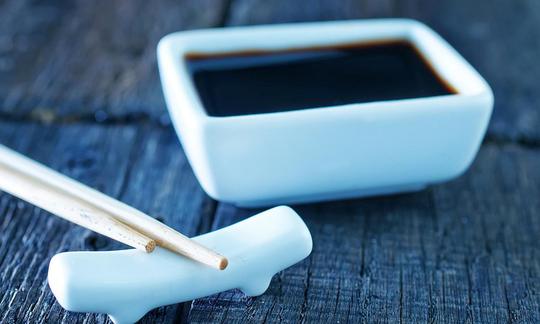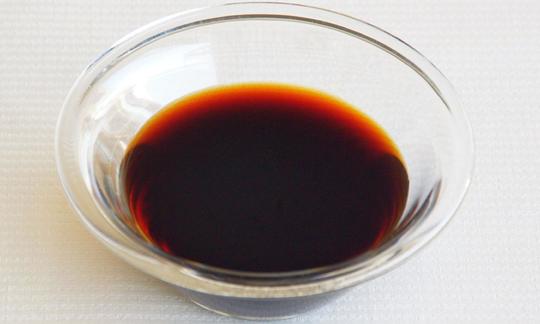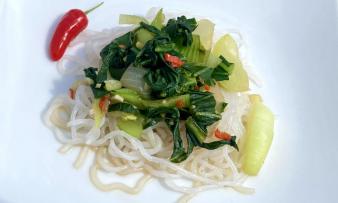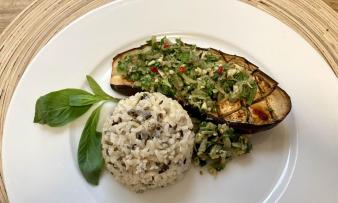Table of contents
Reduced salt soy sauce ( Genen-Shoyu) has a salt content reduced by up to 50%, depending on the manufacturer. Organic quality is preferable, but it remains highly processed and is not raw.
Use in the kitchen
'Shoyu' is Japanese and means 'soy sauce'. Shoyu is a Japanese soy sauce made from soybeans, wheat, water, sea salt and koji (molds of the genus Aspergillus). 1,2 Shoyu has a special taste: 'umami'. In addition to sweet, sour, bitter and salty, umami is the fifth taste that we can perceive with our taste buds on the tongue. The umami taste is described as savory and meaty. 3
In Japan, different types of Shoyu are used in cooking, which differ in color, taste and salt content. There is 'Koikuchi-Shoyu', 'Usukuchi-Shoyu', ' Tamari-Shoyu ', 'Saishikomi-Shoyu' and 'Shiro-Shoyu'. 4 Shoyu with reduced salt is called 'Genen-Shoyu'. This article focuses on the reduced-salt soy sauce (soy sauce). You can read more about the other Shoyu variants in the article " Soy sauce (Shoyu, raw?, organic?) ".
What dishes is soy sauce used for? Soy sauce is a must for Asian dishes in particular (e.g. wok vegetables, fried noodles, fried rice, vegan teriyaki skewers, shirataki noodles with pak choy ) to give them a spicy, hearty flavor. It is indispensable for sushi. As a marinade, soy sauce can give tofu a pleasant flavor. Soy sauce is also used in European recipes. It can be used to refine soups, sauces (e.g. vegan gravy) or salad dressings.
Genen-Shoyu has a lot less salt than conventional soy sauce and is therefore particularly suitable for flavouring dishes and meals that already have a certain salt content. Shoyu should only be heated carefully when cooking and added towards the end to preserve the flavour.
Is soy sauce raw? Soy sauce is not a raw food product. During the manufacturing process, the soybeans are heated, as they are only digestible after this. When raw, they contain the glycoprotein phasin, which is toxic to humans. But there are unpasteurized soy sauces.
What can you replace soy sauce with? If you don't have soy sauce on hand, you can replace it with vegan Worcestershire sauce, Coco Aminos seasoning sauce or simply vegetable stock.
Vegan recipe for Asian vegetable stir-fry with Genen-Shoyu
Ingredients (for 2 people): 200 g smoked tofu, 10 sugar snap peas, 1 carrot, ½ yellow bell pepper, ½ red bell pepper, ½ broccoli, 1 clove of garlic, 4-5 tbsp low-salt soy sauce (Genen-Shoyu; preferably organic), 4 tbsp water, ½ tsp sugar, 2 tbsp rapeseed oil, 1 tsp sesame seeds.
Preparation: Cut the smoked tofu into thin strips. Wash the vegetables, dry them or let them drain. Halve the sugar snap peas. Peel the carrot and cut into slices. Remove the seeds from the sweet pepper and cut into pieces. Separate bite-sized broccoli florets. Peel the garlic clove and chop finely. Mix the soy sauce, water and sugar in a bowl. Heat the rapeseed oil in a pan and fry the tofu for approx. 2 minutes. Add the garlic and vegetables and fry for approx. 2 minutes. Deglaze with the soy sauce-water mix. Sprinkle the vegan vegetable pan with sesame seeds and serve with jasmine rice, for example.
Vegan recipes with soy sauce (Genen-Shoyu) can be found under the note: " Recipes that have the most of this ingredient ".
| Not only vegans or vegetarians should read this: Vegans often eat unhealthily. Avoidable nutritional errors. |
Purchasing - Storage
A few supermarkets, such as Coop, Migros, Spar, Rewe and Billa offer Genen-Shoyu all year round, mostly referred to as reduced-salt soy sauce. In other supermarkets (e.g. Denner, Volg, Aldi, Lidl, Edeka, Hofer) you can't buy reduced-salt soy sauce or you can only buy it during special weeks. Many organic supermarkets (e.g. Denn's Biomarkt, Alnatura) also don't have Gene-Shoyu in their range, but do have conventional organic shoyu. Reduced-salt organic soy sauce can be found in online shops. You also have a good chance of finding Genen-Shoyu in Asian grocery stores.
Low-salt soy sauce usually contains a few more ingredients (e.g. spirit vinegar, sugar, alcohol) than the usual shoyu to replace the preservative effect of salt. In addition, soy sauces are usually pasteurized (but still not raw).
The availability of low-salt soy sauce (Genen-Shoyu) varies depending on the size of the store, catchment area, etc. You can find our recorded food prices for the DA-CH countries above under the ingredient image - and by clicking you can see their development at various suppliers.
Storage tips
Unopened soy sauce bottles should be stored in a cool, dry place away from light. Once opened, it is best to store them in the refrigerator and use them within a few months.
Ingredients - Nutritional values - Calories
The energy content of soy sauce (Genen-Shoyu) is 94 kcal/100g. Carbohydrates are 6.1 g/100g (of which 3.4 g sugar) and proteins 8.6 g/100g. The reduced-salt soy sauce, whose nutritional value we are using here as an example, has a salt content of approx. 8 g/100g (334.4% of the daily requirement). In comparison: Normal soy sauce (Shoyu) has approx. 14 g salt per 100g (581.3% of the daily requirement). 5
Due to a lack of information, we cannot provide any information on the mineral and trace element content. However, these are probably similar to those in soy sauce (shoyu).
The complete ingredients of soy sauce (Genen-Shoyu), the coverage of the daily requirement and comparison values with other ingredients can be found in our nutrient tables. In the article Nutrients explained you will get a detailed insight into the topic.
Health effects
Is soy sauce healthy? Studies on shoyu have shown the following effects: promoting gastric secretion, lowering blood pressure, antimicrobial activity, anticarcinogenic effect and prevention of cataracts. 6 In addition, antioxidant, antihyperuricemic (hyperuricemia = high uric acid levels in the blood) and antiplatelet activities have been demonstrated. Antiplatelet agents prevent blood platelets from sticking together and thus reduce the formation of blood clots. 7 However, the potential health benefits of shoyu have not been fully researched.
The facts about the health of soy come practically only from interested circles (e.g. the food industry) and there is a lack of voices that also emphasize the disadvantages, especially the ecological ones.
Can you lose weight with soy sauce? A 2019 study examined the physiological effects of soy sauce on nematodes ( Caenorhabditis elegans). It found that nematodes fed soy sauce gained less fat than the control group that received salt water. An earlier study from 2012 argued that salt promotes fat accumulation. However, the 2019 trial showed a reduced accumulation of fat in the nematodes' bodies despite the high salt content of soy sauce. Further research is needed to determine the cause and evaluate the transferability of the results to humans. 8
The same study also showed that the nematodes reacted with an increased tolerance to oxidative stress and showed an increased resistance to pathogens after consuming soy sauce. 8
Secondary plant substances
Many of the health effects of soy sauce can be attributed to the secondary plant substances it contains (on the one hand from the soybean and on the other hand through fermentation with koji). Our article on secondary plant substances provides an overview of the classification of the substance groups, their occurrence in foods and possible effects on humans. Soy sauce contains the following secondary plant substances, among others: 7, 9
- Alkaloids : β-Carbolines
- Polyphenols : phenolic acids, isoflavones, furanones, pyranones
- Nitrogen-containing compounds : Melanoidins
However, it should be noted that the composition of the secondary plant substances in soy sauce can vary depending on the brand, time of harvest and growing conditions of the soybeans. Therefore, quantities are only of limited use and should only be understood roughly.
Polyphenols, melanoidins, free amino acids and low molecular weight peptides are associated with the antioxidant effect of soy sauce, which helps reduce oxidative damage by eliminating free radicals and reactive oxygen species. 9
Dangers - Intolerances - Side effects
Although soy and wheat are among the most allergenic foods, soy sauce containing both is hypoallergenic. During fermentation, microbial proteolytic enzymes completely break down the soybean and wheat allergens. 6 However, it is known that some people suffer from skin irritation, dermatitis or cellulite after eating shoyu. These reactions could be triggered by histamine or other substances that are produced during fermentation. 10
Is soy sauce unhealthy? Despite the reduced salt content of Genen-Shoyu, this soy sauce still contains a lot of salt (about 8 g/100g). To illustrate: 1 tablespoon (about 10 g) of Genen-Shoyu contains about 0.8 g of salt. The World Health Organization ( WHO) recommends limiting an adult's daily salt intake to 5 g (2 g of sodium). High salt consumption is associated with an increased risk of high blood pressure, cardiovascular disease, kidney failure, stomach cancer, osteoporosis, obesity and Meniere's disease. 11,12,13,14 Read more about the harmful health effects of excessive salt consumption and ways to reduce your salt intake in the articles on salt and sea salt.
Sugar or other additives are sometimes added to reduced-salt soy sauces - when buying soy sauce, pay attention to the ingredients list to avoid such ingredients. You can find out more about the effects of sugar on the body in the articles on sugar and powdered sugar.
When soy sauce is produced by chemical hydrolysis (without fermentation), carcinogens can form. The byproduct ethyl carbamate (EC) is of particular concern to manufacturers. 23 Although EC is considered moderately toxic, the IARC ( International Agency for Research on Cancer) has classified it as "probably carcinogenic to humans". 25
Ecological footprint - animal welfare
The CO 2 footprint is primarily used to assess the climate friendliness of a food. This depends on various aspects, such as cultivation method (conventional/organic), seasonality, country of origin, processing, transport and, if applicable, packaging. According to The Big Climate Database, the CO 2 footprint of soy sauce is 1.64 kg CO 2 eq/kg, according to Carboncloud 1.23 kg CO 2 eq/kg (soy sauce in glass bottles from Great Britain). 15, 16 In comparison: beef, which can also produce the taste 'umami', causes an average of 13.6 kg CO 2 eq/kg. 17 Other spice sauces, such as chili sauce or barbecue sauce, have a CO 2 footprint of 1.94 CO 2 eq/kg and 2.09 kg CO 2 eq/kg, respectively. 18
The water footprint is approximately 600-1986 l of water per 1 kg of soy sauce produced. The lower value is an average of three soy sauce products (including wheat). The higher value is based on a calculation that includes soybean cultivation and processing into soy sauce in Indonesia (Grobogan) (without including wheat). 19,20
In conventional agriculture, synthetic pesticides are often used to combat unwanted plants and insects. These have been proven to have a negative impact on the environment and affect important pollinators, birds and mammals, among others. Accordingly, when buying soy sauce, you should buy organic products in order to protect biodiversity and your own health. The use of such pesticides is prohibited in organic farming. You can read more about the use of pesticides and biodiversity loss in the articles on wheat and soybeans.
For detailed explanations of various sustainability indicators (such as ecological footprint, CO2 footprint, water footprint), see our article: What does the ecological footprint mean?.
Worldwide occurrence - cultivation
Soy sauce, the traditional East Asian seasoning, originated in China (around 2500 years ago). At that time, it was used primarily to preserve food (due to its salt content) and to enhance the taste of the modest vegetarian Buddhist diet - salt was an expensive commodity at that time. Today, soy sauce is used much more as a seasoning than as a preservative. The spicy sauce is now popular worldwide due to its unique umami taste. 21,22
Shoyu is a soy sauce made according to Japanese tradition. According to legend, a Buddhist monk named Kakushin first made shoyu in Yuasa (Wakayama, Japan) in 1254. 1
Industrial production
The basic ingredients for shoyu production are soybeans, wheat, koji, spring water and sea salt. 2
The moistened soybeans are cooked under high pressure and at high temperatures while the wheat is roasted and ground. The soybeans and wheat are then mixed in a ratio of 1:1 for Japanese soy sauces (4:1 for Chinese variants) and koji molds (especially Aspergillus oryzae and Aspergillus sojae), so-called fermentation starters, are added. Over the next 40 hours, the koji multiply in the mixture. Salt (sodium chloride) and water are then added. The resulting mash is called moromi. In addition to koji molds, it also contains halotolerant lactic acid bacteria and yeasts. The added brine inhibits the growth of harmful molds and promotes the growth of the bacteria. The low pH value, which is due to the lactic acid production by lactic acid bacteria, offers a perfect niche for acidophilic yeasts. Moromi yeasts improve the quality of soy sauce by producing alcohol and volatile flavors. Moromi (mash) is traditionally fermented in wooden tanks for 1 to 2 years, or industrially in large enamel or stainless steel tanks at room temperature for 6-8 months. 1,2 ,21,23
After fermentation and maturation, moromi is pressed to separate the liquid from the mash and thus obtain soy sauce (shoyu). Finally, the soy sauce is filtered in most cases. 1,21
In addition to fermentation, soy sauce can also be produced by chemical hydrolysis by adding hydrochloric acid to hydrolyze the soy protein. The production time is reduced from several months to 1-3 days. Although this method is cheaper and faster, the quality of the soy sauce is not satisfactory. There are not enough aromas and flavors, but there are some undesirable compounds that are absent in naturally fermented soy sauce, including carcinogens (such as 3-chloropropane-1,2-diol and 1,3-dichloropropanol). 23
The demand for low-salt soy sauce has increased due to health concerns related to high sodium intake, such as hypertension and renal dysfunction. However, salt is a crucial element in the fermentation of soy sauce as it regulates the microbial composition during fermentation and organoleptic properties (such as aroma and texture). Reducing the salt content raises microbiological safety concerns and could affect the quality of the final product. 23 ,24
Reducing the amount of salt during fermentation would require some adjustments. Some studies have found that this approach favors the production of soy sauce by speeding up the fermentation. High salt content in moromi can slow down microbial metabolic activity, so a period of about 6 months is required to complete fermentation. To speed up the fermentation process while maintaining quality, a low salt concentration can be combined with some physical treatments. A 1993 study successfully shortened the process of soy sauce production by reducing the salt content in moromi to 4.6% and autolyzing the koji mold at high temperature before fermentation. This treatment resulted in soy sauce with a chemical composition and flavor similar to traditional soy sauce. A more recent study from 2016 showed that the fermentation time of moromi with reduced salt content (NaCl 10%) could be significantly reduced to 4.6 days by carrying out the fermentation process at high temperature (40.7 °C). 24
To reduce microbiological safety concerns, alcohol (ethanol) can be added as a partial replacement for the reduced salt to prevent the growth of pathogenic and spoilage microorganisms. However, the use of alcohol could also limit the growth of desirable microorganisms. A 2019 study concludes that reducing the salt content in soy sauce requires the development of robust starter cultures that are stable and active against environmental perturbations. 24
In contrast, famous soy sauce manufacturers state that they produce their low-salt sauces in exactly the same way as conventional soy sauces and only remove about 40% of the salt after fermentation is complete in order to preserve taste and quality characteristics. We have not found any precise details about this process.
Further information
You can also find detailed articles about the following soy sauces: Shoyu, Tamari and sweet soy sauce.
Alternative names
In English, soy sauce is called soy sauce or soya sauce. Salt-reduced soy sauce is known in English as low sodium soy sauce, less sodium soy sauce or salt reduced soy sauce.
In Chinese, soy sauce is called jiangyou, in Japanese it is called shoyu. 22
Bibliography - 25 Sources
| 1. | Murooka Y, Yamshita M. Traditional healthful fermented products of Japan. J Ind Microbiol Biotechnol. August 2008;35(8):791–798. |
| 2. | Shimbo H. The japanese kitchen: 250 recipes in a traditional spirit. Beverly: Harvard Common Press; 2000: 536. |
| 3. | Gabriel AS, Rains TM, Beauchamp G. Umami: taste for health. Cham: Springer Nature; 2023: 205. |
| 4. | Lioe HN, Apriyantono A, Yasuda M. Soy Sauce: Typical Aspects of Japanese Shoyu and Indonesian Kecap. In: Hui YH, Özgül Evranuz E (Ed.) Handbook of plant-based fermented food and beverage technology. 2. ed. Boca Raton: CRC Press; 2012:93-102. |
| 5. | USDA United States Department of Agriculture. |
| 6. | Kataoka S. Functional effects of Japanese style fermented soy sauce (Shoyu) and its components. Journal of Bioscience and Bioengineering. 2005;100(3):227–234. |
| 7. | Peng M, Liu J et al. Effect of citrus peel on phenolic compounds, organic acids and antioxidant activity of soy sauce. LWT. 2018;90:627–635. |
| 8. | Sugawara T, Saraprug D, Sakamoto K. Soy sauce increased the oxidative stress tolerance of nematode via p38 MAPK pathway. Bioscience, Biotechnology, and Biochemistry. 3. April 2019;83(4):709–716. |
| 9. | Qiao Y, Zhang K et al. Fermented soybean foods: A review of their functional components, mechanism of action and factors influencing their health benefits. Food Res Int. 2022;158:111575. |
| 10. | Sugiura K, Sugiura M. Soy sauce allergy. J Eur Acad Dermatol Venereol. 2010;24(7):852–855. |
| 11. | Galvis-Sánchez AC, Lopes JA et al. Chapter 26: Sea Salt. In: De la Guardia M, Gonzáles A (Ed.). Comprehensive Analytical Chemistry. 2013;60:719-740. |
| 12. | Rosa A, Pinna I et al. Flavoring of sea salt with Mediterranean aromatic plants affects salty taste perception. J Sci Food Agric. 2022;102(13):6005-6013. |
| 13. | WHO World Health Organization. Sodium reduction. 2023. |
| 14. | Agócs R, Sugár D, Szabó AJ. Is too much salt harmful? Yes. Pediatr Nephrol. September 2020;35(9):1777–1785. |
| 15. | The Big Climate Database (Version 1.1): Soya sauce. 2024. |
| 16. | Carboncloud. ClimateHub. Soy sauce, glass bottle. 2023. |
| 17. | Reinhardt G, Gärtner S, Wagner T. Ökologische Fussabdrücke von Lebensmitteln und Gerichten in Deutschland. IFEU Institut für Energie - und Umweltforschung Heidelberg. 2020 |
| 18. | The Big Climate Database (Version 1.1): Chili Sauce; Sauce, barbeque. 2024. |
| 19. | Sharaai AH, Ismail ND. The water footprint of soy sauce. J wast bio manag. 2020;2(1):01–04. |
| 20. | Aulia Firda A, Purwanto. Water footprint assessment in the agro-industry: a case study of soy sauce production. E3S Web Conf. 2018;31:08018. |
| 21. | Cao ZH, Green-Johnson JM et al. Bioactivity of soy-based fermented foods: A review. Biotechnol Adv. 2019;37(1):223-238. |
| 22. | Diez-Simon C, Eichelsheim C et al. Chemical and Sensory Characteristics of Soy Sauce: A Review. Journal of Agricultural and Food Chemistry. 2020;68(42):11612-11630. |
| 23. | Sassi S, Wan‐Mohtar WAAQI et al. Recent progress and advances in soy sauce production technologies: A review. J Food Process Preserv. 2021;45(10):e15799. |
| 24. | Devanthi PVP, Gkatzionis K. Soy sauce fermentation: Microorganisms, aroma formation, and process modification. Food Res Int. 2019;120:364-374. |
| 25. | LGL Bayern. Toxische Reduktionsprodukte Ethylcarbamat (EC). 2018. |











Comments